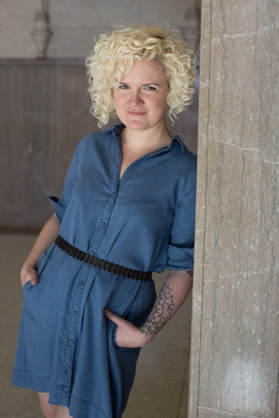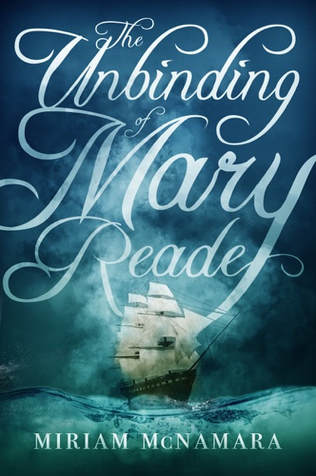 I am so excited to catch up with author Miriam McNamara about her debut novel "The Unbinding of Mary Reade." Read on to learn more about her process writing and creating Mary! Q: Can you share with us how the idea for "The Unbinding of Mary Reade came to you and how long it took for the story to eventually take the form it has now?" A: I first came across Mary’s story when I was an undergrad in college and took a history class about early America. On top of the concept of Caribbean pirate culture being an early iteration of American democracy, I was so intrigued by the idea of the relationship between the two women that were part of Jack Rackham’s crew. Their story was full of queerness—gender-bending on so many levels, the seductive nature of their relationship with each other, their complex and outlaw relationship with society and the roles they were expected to play in it. When I decided I wanted to try my hand at writing a novel years later, I knew instantly that I wanted to write a version of their story where all of the elements that drew me to them took center stage. Q: Your grasp of the language in this book is incredible! You did such good work on using accurate language for a sailor and pirate. How were you able to do this? What kinds of sources did you use in the research process? A: Thanks so much! I feel like my process is so all over the place. I read historical fiction set at the time, books written at the time, books specifically on pirates, books on pirate language in history and the media and on slang at the time. I googled language and dialect and syntax, and I used an online etymological dictionary on what felt like every word in the novel! I’m sure one or two anachronisms slipped through, but I’m pretty happy with how it turned out. My research in general happened pretty similarly. I had a few history books I leaned heavily on: "1700: Scenes from London Life" by Maureen Waller and "The Republic of Pirates" by Colin Woodard. "Moll Flanders" by Daniel Defoe and "A General History of the Robberies and Murders of the Most Notorious Pirates" by Captain Charles Johnson were books that were written at the time. "Fanny" by Erica Jong and was a contemporary book set at the time that influenced my story. I have transcripts of Mary and Anne’s trial that informed the book. But I also read all sorts of random books and internet articles and went down a thousand rabbit holes. All of it enriched the story in little ways.  Q: The sexy scenes in The Unbinding of Mary Reade are so good! Can you tell us a little about how you write sexy moments? What makes them hot--or not? Any tips for the first-time writer? A: Hooray! :) Those are some of my favorite scenes in the books, and it makes me really happy to hear that many readers love them, too! You are the first person to ask me about how I’ve written them, though, so this is especially exciting. There is a good book called "The Joy of Writing Sex" by Elizabeth Benedict that is a good place to start for fiction writers. Essentially, the main thing you want to remember when writing sex (or make out) scenes is that they should follow the main rules of any scene: moving the plot of the story forward while also evolving the emotional landscape, changing or informing the protagonist in some way. If the scene doesn’t do this, it’s probably gratuitous and will end up feeling that way, no matter how well-written it is. Before I write a sexy scene I think about what the characters are going through, and I try to come up with a general idea for the scene that would reveal their emotional states to each other or the reader and hopefully maybe even touch on the themes of the novel as a whole (although that isn’t necessary, just a bonus). When I sit down to write the scene once I’ve got a general idea, I try to draft it first without being self-conscious. Generally speaking, it comes out a little overwrought and includes a lot of repetitive language the first time I write it. The people in the scene might act out of character because I thought it was sexy in the moment. But I have to turn off that internal editor in order to get a good first draft, and in editing you can really fine-tune it. I don’t think there are rules for what sorts of words should be used or not used, or how graphic the scene should be—it should feel cohesive with the tone of the rest of the novel, and it should feel right to you, the writer. Q:Did publishing your book change the way you felt about yourself as a writer? How? What is different now? A: Being published was always a goal that I was working toward, and it’s such a hard one to realize! So much is outside of the author’s control. All you can do is write the best story you can write and then be willing to risk rejection over and over. I love the validation that being published brings, and I love hearing from people that have read and loved the book. Other than that, not much has changed! It’s a very significant step in my writing journey, but it’s also just one of many. It’s become part of the journey instead of the goal. Q: I’m really inspired by the fluidity your characters, especially Mary, have in describing the way they are attracted to people of both genders. Did you start out with the goal for your character to be gender fluid? Or did that reveal itself in the writing of the book? A: Mary’s sexuality and gender were clear to me from the start. I specifically wanted to write a character where both of these things were fluid, who didn’t fit on either side of either binary, whose authentic identity existed outside of any clear definitions. However, this ended up being really hard to nail down in the writing! Initially I thought of her gender and sexuality as ambiguous. I was told early on that ambiguity is really hard to write, which I found to be true. Early readers got ideas about Mary’s character or what I was trying to say about sexuality or gender that I wasn’t intending. It took me a while to nail down how fluidity is different than ambiguity, although there is some overlap, and then write that fluidity unambiguously (if that makes sense!). It really takes a whole novel to fully show it, which I love. Q: I just want to say how inspired I am by the subject matter in Mary Reade! I love when stories turn our idea of history upside down. Queer, non-binary pirates, hooray :) I want more!I heard a rumor that you have a new book coming out, so my last question is when can we read more like Mary Reade? A: Speaking of my second project, it is another queer historical novel! This one is set in 1930 in New York and Chicago, just after the stock market crash. It’s about a girl whose perfect life falls apart. She runs off determined to chase it down and ends up joining a barnstorming circus…there’s wingwalking, hot pilots, WWI-era biplanes, speakeasies, jazz, making out, and tons of stunts based on true stories. It’s about losing the life you thought you were going to have, and finding out that what unfurls in its place is so much more expansive and limitless than what you had imagined before. It’s titled "An Impossible Distance to Fall," and it’s scheduled to release in June 2019. Thanks so much for asking! :) Thanks to Miriam for sharing her process and thoughts about Mary Reade with us. The book is available at Amazon, Goodreads, and Barnes & Noble--or you can pick up your copy at our favorite local bookstore, Malaprops! |
AuthorCoranna Adams is a writer, filmmaker, and educator from Asheville, North Carolina. Archives
December 2023
Categories
All
|
|
Click to set custom HTML
|
Site Copyright Coranna Adams, 2023 all rights reserved. Do not copy or reproduce without permission.
|

 RSS Feed
RSS Feed